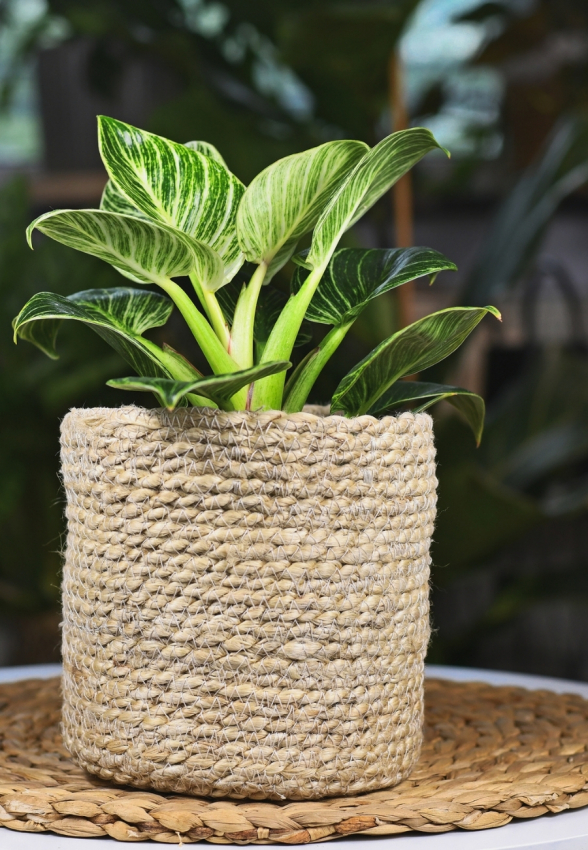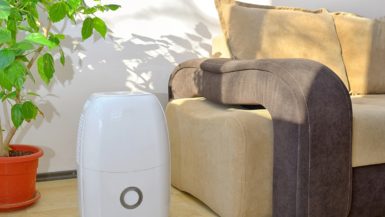Philodendron Birkin is one of the more interesting houseplants. Its existence was entirely unplanned. When the Philodendron Rojo Congo was being cultivated, the Philodendron Birkin was accidentally born as the result of a mutation.
One of the best characteristics about the Philodendron Birkin is that it will grow leaves that directly resemble the Rojo Congo. It will also randomly grow white leaves too. Its random nature is part of its allure and the reason so many people include this plant as part of their household collection.
Lighting Guide for the Philodendron Birkin
Like other tropical rainforest plants, the Philodendron Birkin prefers bright but indirect light so you will need to place it in a location that doesn’t get direct sunlight. Otherwise, the leaves will get scorched and the health of the plant will suffer.
You’ll find that the best location is a corner of a well-lit room away from any windows. However, the Philodendron Birkin is tricky because of its variations. White leaves will require brighter light in order to thrive. On the other hand, green leaves require less light.
You might need to relocate the plant during different seasons and based on the variation of leaves that pop up. For instance, you might have to move it to a place that gets more light during the winter months and into lesser-lit rooms in the summer.
Philodendron Birkin Proper Watering Guide
One of the biggest problems with the Philodendron Birkin is that people tend to overwater it. It prefers lightly moist soil. However, soil needs to dry out between watering sessions. In fact, it’s better to underwater the Philodendron Birkin than it is to overwater it.
Let the top layer of soil completely dry out before applying water to the plant. Once the top layer is dry, lift the plant to determine how dry the entire pot of soil is and only water once it has been slightly dried out.
When watering, soak the soil until water drains from the holes in the bottom of the pot. You’ll have to apply water slowly because dry soil takes a little bit to soak up water. Once the water drains from the bottom, stop watering and then empty the tray.
Root rot will occur if you leave water in the drainage tray so keep that in mind. You will only need to water the Philodendron Birkin once a week during spring and summer, but far less than that during the fall and winter months.
Finally, you can use normal tap water for this plant since it’s not sensitive to specific minerals. If you start seeing signs of resistance in the leaves and foliage, then change over to distilled or rainwater.

Soil and Potting Requirements
Since the Philodendron Birkin hates being soaked in water, you’ll need to plant it in soil that drains well. However, the soil also can’t dry out too quickly either so you’ll need to find a good balance. The best combination is either of these:
- One-third perlite and two-thirds houseplant potting soil
- One-third perlite and two-thirds peat
You’ll need to replant the Philodendron Birkin at least once every year for as long as you want the plant to grow. So when the roots starts showing out of the bottom of the pot, it’s time to repot this amazing plant.
You should increase the size of the pot by no more than two inches. Growing the Philodendron Birkin in a pot that’s too big will increase the risk of overwatering and can lead to other detrimental problems.
When you have the plant out of its pot for repotting, you might as well use the opportunity to check the roots. Look for signs of root rot. If there is evidence of it, then prune away the infected areas before repotting. Then repot in the new potting soil and water the plant thoroughly.
Humidity and Temperature Requirements
The Philodendron Birkin thrives in a warm, humid environment so you will need to ensure that your home meets this requirement. If your home is under 40% humidity, then you will need to simulate it by either misting the plant with water or by adding water to a tray of pebbles directly under the plant.
Some people will keep this plant in the kitchen or bathroom since those areas are humid by nature.
Temperatures must be between 60 and 85 degrees for the Philodendron Birkin to remain healthy. Anything below 60 degrees will stunt its growth and potentially damage it.
Drafts are a main concern for indoor plants so be sure to keep it away from air conditioning and heating vents. Cold, drafty windows can also be a problem if you live in a temperamental climate.
Feeding the Philodendron Birkin
This beautiful houseplant prefers water-soluble fertilizers. You should add food into the water every three watering session during the spring and summer seasons. However, it requires far less feed during the fall and winter months when it’s dormant.
Organic fertilizers also work quite well and are far less risky since it’s difficult to over-fertilize with natural foods. You can add some worm compost into the potting soil to help provide the necessary nutrients.
Propagating the Philodendron Birkin
The best method of propagation is to use stem cuttings. Always propagate the plant during spring when it’s growing at its strongest.
First and foremost, be sure that you properly sterilize the trimmers before using them on the plant. A cutting should have at least one growth node on it for the best chance of success.
You should propagate the cutting in water for at least 6 weeks, waiting for new roots to start developing before placing it into soil. While you can place the cutting directly in soil, water increases the chances of successful propagation.

Pests and Disease Control
Typical pests are not a huge issue with the Philodendron Birkin but you should still check your plant for infestations. If you don’t get rid of them immediately, then they will get so severe that they could kill the plant. The most common pests are spider mites, mealybugs, and thrips. Spider mites are the most difficult to identify, making them the most dangerous.
You should inspect your plant every week. Check leaves closely to see if there are any signs of bugs. If there are, then use a damp cloth to wash the plant. If the infestation is too great, try spraying the plant with a showerhead.
Neem oil and horticultural soap are also great options to get rid of infestations fast. Just don’t apply them more than once a week.
As far as diseases go, the main one you’ll encounter with the horticultural soap is Xanthomonas. This occurs when the plant is under watered so following a proper watering routine will prevent it.
Is the Philodendron Birkin Toxic?
I recommend that you keep it away from pets and children. While it’s not deadly, ingesting the Philodendron Birkin can lead to nausea and vomiting.
Hopefully, this Philodendron Birkin care guide has helped you develop a routine for taking care of this amazing plant. That way, you can enjoy all of the benefits that come with it. If you’re running into problems, then think carefully about each aspect of its care and make sure you’re following everything. There will be times when adjustments have to be made to meet the exact needs of the plant.






Leave a reply